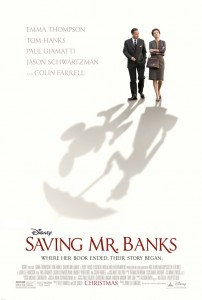Title: Saving Mr. Banks

Summary:
The reasonably true story of Walt Disney’s struggle with the intransigent author, P.L. Travers, and how they managed, through a fairly epic struggle, to bring Mary Poppins to the screen. It is also the possibly true story of Travers’ early life in Australia and her relationship with her loving but self-destructive father.
Appropriate for:
Ages 10 and up
A story featuring Walt Disney himself about the making of Mary Poppins? Surely this is an all-ages romp! Well, not exactly. The story of Travers’ youth is actually quite harrowing. When it was over our kids gave the Disney part a big thumbs up and the Australia part a thumbs down – too grown up.
Content Warnings:
I could mention how Walt Disney drinks a whiskey and someone says “damn” at some point but it seems silly compared with the bloody, drunken, and suicidal fun of Australia.
There’s a dead body, although the death happens off-screen. It’s really not a kids movie.
The Scoop:
The film’s advertising focused primarily on the delightful interplay between P.L. Travers and the Disney creative team with the implied promise that we would be seeing the real life story that inspired Mary Poppins. This is true only to a limited extent because the story of Travers’ hard early life doesn’t really involve a Mary Poppins character until only very late. Her father, who desperately needs saving, is not really rescued by Aunt Ellie/Mary Poppins – despite Walt Disney’s epiphany that she is there, not to save the children, but the father.
In this light, the original story of Mary Poppins can be seen as a fantasy of redemption that Travers is striving for, and defending from, Disney. In the context of the movie it works because we get to see Travers softening to and accepting the adaptation, not just because the Sherman brothers are so charming, but because the creative team finds a way to redeem Mr. Banks and thus bring the fantasy that her father could be saved to the movie.
The acting in both movies – I really am tempted to toss out the idea that this was one film – was top notch. Emma Thompson and Tom Hanks are charming as ever and Paul Giamatti proves the old adage that there are no small parts. Colin Farrel was excellent as Travers’ father but the minute he showed up I knew things were likely to end badly. He doesn’t make very many happy movies.
These two movies are packed with duality and not just because it’s two movies in one. I found the many and various parallels drawn between Disney and Travers to be interesting in light of their antagonistic relationship. And it’s the parallels that ultimately help Disney to seal the deal.
We really enjoyed half of this movie and would have been even more delighted if the filmmakers had spent far more time with Disney and Travers. Not least because over the closing credits they play actual audio of the real P.L. Travers bossing around the creative guys. It’s a wonderful device to demonstrate that at least some of what we just watched was absolutely true.